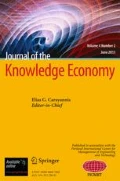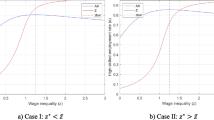Abstract
This paper calibrates the Cobb-Douglas (CD) model of US aggregate production with empirically derived values of the relative shares of capital and labor. A conceptual framework is developed to show how technological progress can affect the relative importance of these shares in US production. To identify and track the transmission of technical change to the macro-economy, the CD model is transformed into the Solow growth model. Specific examples of different types of technical change are developed to illustrate their effect on the task structure of jobs, the capital/labor ratio, total factor productivity (TFP), and US aggregate output. These examples are supported with graphical and flowchart analyses providing intuition concerning the implications of technical change on the production process and the relative importance of the input shares of capital and labor. Some broader aspects of technical change are discussed including the task structure of future jobs and the importance of aligning the skills workers acquire with task requirements of US industry.






Similar content being viewed by others
Notes
Other assumptions of the CD model include: constant-returns-to-scale (CRS), profit maximization, competitive input and output markets, Hicks-neutral technical change (see “The Nature of Technological Progress”), capital and labor income shares are constant and the elasticity of substitution between capital and labor equals unity in the long run (Ơ = 1). The (Ơ) is a measure of the responsiveness of the optimal capital/labor combination to a change in the relative prices of the two inputs. It measures the ease in which capital can be substituted for labor. In general form, Ơ = (% change in K* / L*)/% change in PL/Pk. If Ơ > 1, the two inputs are gross substitutes. If Ơ < 1, the two inputs are gross complements (Boskin and Lau 2000; Ramskov and Munksgaard 2001; Acemoglu 2002).
For simplicity, I will refer to output per capita as “output.”
These influences include work practices, unions, the elasticity of demand for goods and services, literacy of workforce, training and education of workers, government regulations, omitted variables, model misspecification, aggregation bias, measurement error among others (Prescott 1997; Hulton 2001).
This subsection is partially adapted from Hatipoglu et al. (2014).
The benefits of capital-augmented technical change are higher with greater capital accumulation in the economy (Boskin and Lau, 2000).
See Golden and Katz (2008) (Chap. 9) for a discussion of the low international ranking of US 15-year-olds in mathematics, literacy, and problem-solving skills.
Capital-saving technical change requires the rise in the absolute share of labor be offset by the decline in the absolute share of capital in order to produce a constant level of output. If each factor is paid its MP, then Euler’s Theorem holds where Ǭ = MPL (L) + MPK (K). In this equation, MPL(L) = the absolute share of labor and MPK(K) = the absolute share of capital.
To produce a constant level of output, the absolute share of capital would rise by the same amount of decline in the absolute share of labor.
Note that Euler’s Theorem guarantees higher output levels resulting from Hick-neutral technical change. As the MP of all inputs rise with a constant capital/labor ratio, the absolute shares of capital and labor rise corresponding to higher output.
With skill-biased technical change, the rise in the absolute share of capital exceeds the absolute share of labor leading to higher output.
See endnote 10.
See Frey and Osborne (2013) for estimates of the degree of susceptibility various occupations are to computerization.
References
Acemoglu, D. (2002). “Labor and Capital-Augmenting Technical Change,” http://dspace.mit.edu/bitstream/handle/1721.1/63815/laborcapitalaugm00acem.pdf?sequence=1. Accessed 6 July 2014.
Antras, P. (2004). “Is the U.S. Aggregate Production Function Cobb-Douglas? New Estimates of the Elasticity of Substitution,” Contributions to Macroeconomics,”4, Issue 1: 1–34, http://scholar.harvard.edu/files/antras/files/cespublished.pdf. Accessed 26 July 2014.
Autor, D. H. (2013). The ‘task approach’ to labor markets: an overview. Journal of Labor Market Research, 46, 185–199.
Autor, D. H., & Dorn, D. (2013). The growth of low-skill service jobs and the polarization of the U.S. labor market. American Economic Review, 103(5), 1553–1597.
Autor, D. H., & Handel, M. J. (2013). Putting tasks to the test: human capital, job tasks and wages. Journal of Labor Economics, 31(2), S59–S96.
Autor, D. H., Levy, F., & Murnane, R. J. (2003). The skill content of recent technological change: an empirical exploration. Quarterly Journal of Economics, 118(4), 1279–1333.
Autor, D. H., Katz, L. F., & Kearney, M. S. (2008). Trends in U.S. wage inequality: revising the revisionists. The Review of Economics and Statistics, 90(2), 300–323.
Bannock, G., Baxter, R. E., & Davis, E. (1998). The Penguin Dictionary of Economics. London, UK: Penguin.
Blankenau, W. F., & Cassou, S. P. (2011). Industry estimates of the elasticity of substitution and the rate of biased technical change between skilled and unskilled labor. Applied Economics, 43(23), 3129–3142.
Boskin, M.J. and Lau, L.J. (2000). “Generalized Solow-neutral technical progress and postwar economic growth,” National Bureau of Economic Research Working Paper 8023, http://web.stanford.edu/~boskin/Publications/NBER-W8023.pdf. Accessed 6 July 2014.
Bureau of Labor Statistics (2013), U.S. Department of Labor, Information retrieved from: www.bls.gov.
Carayannis, E. G. (2001). The strategic management of technological learning. Boca Raton, Fl: CRC Press.
Chen, B., Mo, J. and Wang, P. (2006). “Neutral technical progress in two-sided micro-matching,” 1–22, http://pingwang.wustl.edu/working_papers/micromatch-8-31-06.pdf. Accessed 21 July 2014.
Elsby, M.W., Hobijn, B. and Sahin, A. (Fall, 2013). “ The decline of the U.S. labor share,” Brookings Papers on Economic Activity, 1–63, http://www.brookings.edu/~/media/Projects/BPEA/Fall%202013/2013b_elsby_labor_share.pdf. Accessed 3 July 2014.
Frey, C.B. and Osborne, M.A. (2013). “The future of employment: how susceptible are jobs to computerization?” 1–72, http://www.oxfordmartin.ox.ac.uk/downloads/academic/The_Future_of_Employment.pdf. Accessed 8 July 2014.
Golden, C., & Katz, L. (2008). The race between education and technology. Cambridge, MA and London, K: Harvard University Press.
Harrod, R. F. (1939). An essay in dynamic theory. Economic Journal, 49, 14–33.
Hatipoglu, O., Macroeconomics Lecture Notes, Department of Economics, Bogazici University, Istanbul, Turkey, http://www.econ.boun.edu.tr/hatipoglu/ec308/lecture3.pdf. Accessed 21 July 2014.
Hicks, J. R. (1932). The theory of wages. London, UK: MacMillan.
Hornstein, A., Krusell, P. and Violante, G.L. (2004). “The effects of technical change on labor market inequalities, “ Federal Reserve Bank of Richmond Working Paper 04–08, 1–128, http://richmondfed.org/publications/research/working_papers/2004/pdf/wp04-8.pdf. Accessed 2 July 2014.
Hulton, C.R. (2001). “Total factor productivity—a short biography,” in Hulten, C.R., Dean, E. and Harper, M. (Eds.), New Developments in Productivity Analysis, Studies in Income and Wealth, Vol. 63, University of Chicago Press for National Bureau of Economic Research, Chicago, IL,1-47, http://www.nber.org/chapters/c10122.pdf. Accessed 20 July 2014.
Idson, T. L., & Oi, W. Y. (1999). Workers are more productive in large firms. American Economic Review, 45, 1–28.
Kaldor, N. (1957). A model of economic growth. The Economic Journal, 67(268), 591–624.
Karabarbounis, L. and Neiman, B. (April, 2014). “The global decline of the labor share,” Quarterly Journal of Economics, 129, Issue 1: 206–223, http://faculty.chicagobooth.edu/loukas.karabarbounis/research/labor_share.pdf.Accessed 29 July 2014.
Klump, R., McAdam, P., & Willman, A. (2007). Factor substitution and factor-augmenting technical progress in the United States: a normalized supply-side system approach. The Review of Economics and Statistics, 89(1), 183–192.
Levy, F., & Murnane, R. J. (2004). The new division of labor—how computers are creating the next job market. Princeton, NJ and Oxford, UK: Russell Sage Foundation, New York and Princeton University Press.
McGahagan, T., (2000). “The Solow growth model,” Department of Economics, University of Pittsburgh at Johnstown, http://www.pitt.edu/~mgahagan/Solow.htmAccessed 5 July 2014.
OECD.statextracts, http://stats.oecd.org/. Accessed 8 July 2014.
Piketty, T. (2014). Capital in the twenty-first century. Cambridge, MA and London, UK: Harvard University Press.
Prescott, E.C. (1997). “Needed: a theory of total factor productivity,” Federal Reserve Bank of Minneapolis Research Department Staff Report 242, 1–48, http://www.minneapolisfed.org/Research/sr/sr242.pdf. Accessed 10 July 2014.
Ramskov, J. and Munksgaard, J. (2001). “Elasticities—a theoretical introduction, “ Balmorel Project, http://balmorel.com/Doc/B-ElastTheory0201.pdf. Accessed 2 July 2014.
Raurich, X., Hector, S. and Sorolla, V. (Sept. 2011). “Factor shares, the price markup and the elasticity of subtitution between capital and labor,” IZA Discussion Paper No. 5992, http://ftp.iza.org/dp5992.pdf. Accessed 29 July 2014.
Saint-Paul, G. (2008). Innovation and inequality: how does technical progress affect workers? Princeton, NJ: Princeton University Press.
Solow, R. M. (1956). A contribution to the theory of economic growth. Journal of Political Economy, 70, 65–94.
Solow, R. M. (1957). Technical change and the aggregate production function. The Review of Economics and Statistics, 39, 312–320.
Woods, J.G. (2007). “Regional economic growth and income distribution in California,” Journal of Business and Public Affairs, 1, No. 1: 1–30, http://www.scientificjournals.org/journals2007/articles/1201.pdf. Accessed 2 June 2014.
Woods, J. G. (2012). An analysis of apprentices in the U.S. construction trades: an overview of their training and development with recommendations for policy makers. Education and Training, 54(5), 401–418.
Woods, J. G. (2014). Pathways of technological change: an epidemiological approach to structural unemployment in the U.S. service sector. International Journal of Social Ecology and Sustainable Development, 5(1), 1–12.
Acknowledgments
I thank Emily Gipson for technical research assistance.
Author information
Authors and Affiliations
Corresponding author
Rights and permissions
About this article
Cite this article
Woods, J.G. The Effect of Technological Change on the Task Structure of Jobs and the Capital-Labor Trade-Off in US Production. J Knowl Econ 8, 739–757 (2017). https://doi.org/10.1007/s13132-015-0275-2
Received:
Accepted:
Published:
Issue Date:
DOI: https://doi.org/10.1007/s13132-015-0275-2




